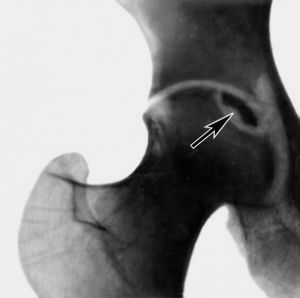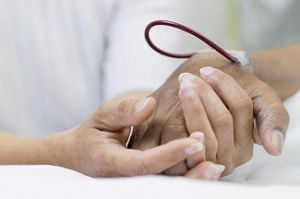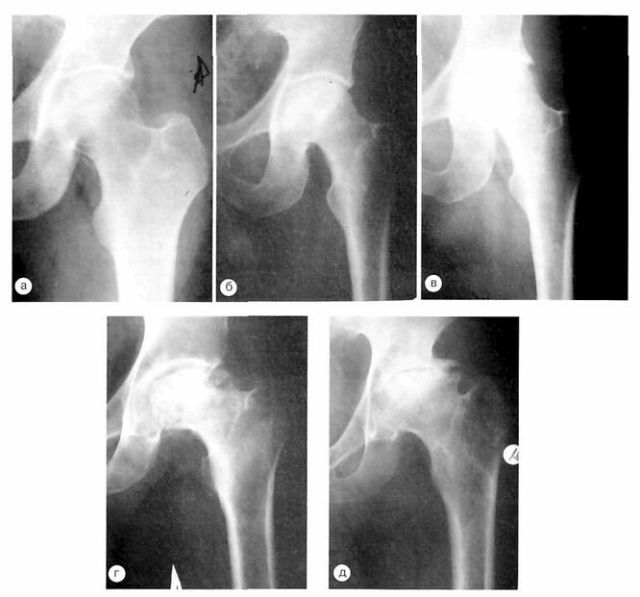
Osteonecrosis - suffices a dangerous disorder, which occurs when there is a shortage of blood circulation in the bone .As a result, the process of cell death begins.
If it is not stopped, it is fraught with complete destruction of the bone.
The most commonly diagnosed osteonecrosis of the hip joint. In addition, violations can occur in the area of the knees, arms, shoulders.
If the time does not begin treatment, the consequences can be most unpredictable.
Contents of the article
- What is the essence of pathology?
- What joints affects the disease?
- Causes and risk factors
- How to identify the disease?
- Diagnosis of
- Treatment should be timely and comprehensive
- Surgery is a necessary measure
- Consequences severe and unpredictable
- Preventive measures
What is the pathology?
This term refers to a serious disease of the joints of a degenerative-dystrophic nature. It is accompanied by necrosis of tissues, which is associated with a deficiency of blood supply.
Since pathogenic microorganisms do not take part in the process, osteonecrosis is usually called aseptic.
What joints affects the disease?
Depending on the location of the pathological process, these types of pathology are distinguished:
- necrosis of the hip joint;
- knee necrosis;
- necrosis of the shoulder joint.
In most cases, pathology affects the head of the femur. However, osteonecrosis of the knee and shoulder joint is often diagnosed, and it can also localize on the wrists and feet.
If the disease has non-traumatic origin, 70% of cases are bilateral. Necrosis of the hip occurs in men several times more often than in women.
In this case, osteonecrosis of the knee joint is typical for older women.
It can be concluded that this pathological process affects those areas that are subject to the greatest load. In more rare cases, osteonecrosis of the jaw is diagnosed.
Depending on the degree of development, these types of disorders are distinguished:
- Stage 1 - normal;
- Stage 2 - sclerotic and cystic disorders;
- Stage 3 - symptom of the crescent;
- Stage 4 - the appearance of osteoarthritis and the growth of osteophytes.

Causes and risk factors for
The following factors most often lead to the development of osteonecrosis:
- Drinking a large amount of alcohol , which causes a violation of blood circulation in the bone.
- Administration of corticosteroids .Such drugs provoke bone destruction due to blocking osteoblast activity. It is especially dangerous to take such drugs for a long time.
- Smoking .Sickle cell anemia .
- Bone injuries , accompanied by serious circulatory disorders.
- Systemic disruption of connective tissue , which causes damage to the vascular endothelium.
- Radiation therapy .
In the risk group for the development of osteonecrosis there are such categories of people:
- young patients 25-40 years;
- people with severe bronchial asthma who require prolonged use of corticosteroids;
- reception of bisphosphonates, which is not supplemented by the application of vitamin D and calcium.
Doctors say that this substance increases the likelihood of osteoperosis of the jaw, and with each year the number of such people increases.
Also, the development of this disease in the jaw region may be due to periodontitis, the lack of oral hygiene, the use of bisphosphonates, tooth extraction.
 How is the habitual dislocation of the shoulder treated in a hospital? What types of operations exist and how is rehabilitation carried out.
How is the habitual dislocation of the shoulder treated in a hospital? What types of operations exist and how is rehabilitation carried out. Spondylolisthesis of the lumbar spine can lead to serious complications up to disability and complete immobilization of the spine. Find out the details!
How to identify the disease?
There are no symptoms at an early stage of the disease.
When the disorder progresses, the following manifestations occur:
- Joint pain, which gradually increases. When the bone is broken, the pain syndrome can become unbearable.
- Painful sensations in a state of rest.
- Restriction of motor activity.
The development of the disease by stages can occur within a few months or a whole year. It is very important to detect a violation as early as possible so that the treatment is as effective as possible.
Diagnosis of
To identify osteonecrosis and to determine the stage of the disease, the following methods are used: 
- joint radiography;
- bone scanning;
- magnetic resonance imaging;
- measurement of intraosseous pressure.
It should be borne in mind that radiography at the initial stages of the disease does not provide an opportunity to identify a violation. Therefore, it is necessary to perform magnetic resonance imaging or computed tomography.
These studies provide an opportunity to detect pathology at any stage of development.
Treatment should be timely and comprehensive.
Treatment of osteonecrosis should be aimed at restoring the damaged joint , preventing the progression of the disease, reducing pain.
The sooner the treatment of the disease begins, the more effective the results can be achieved. In some cases, surgical intervention can not be avoided, which helps to reduce pain and prevent the collapse of the joint head.
At the initial stage of treatment it is necessary to unload the affected area. For this use canes, crutches or completely restrict walking.
In addition, often prescribed painkillers. The use of oxygen at high pressure helps to eliminate the appearance of new areas of dead tissue.
Conservative therapy is effective only in the early stages of osteonecrosis. If the knee or hip joint is affected, surgery can not be avoided.
Surgery is a necessary measure of
The goal of surgical intervention is to preserve the bone - this avoids prosthetics. There are several types of operations:
- Decompression .A hole is made in the head of the damaged bone, which reduces the pressure, which prevents the development of collapse.
- Osteotomy .In this case, remove a portion of the unhealthy bone and perform an artificial restoration.
- Autotransplantation .In doing so, take a piece of healthy bone and transplant to the site of the affected area.
 If a person has osteonecrosis of the jaw, antibacterial drugs and special rinse products are used.
If a person has osteonecrosis of the jaw, antibacterial drugs and special rinse products are used.
It is also necessary to surgically remove dead tissue and eliminate the inflammatory process.
Consequences severe and unpredictable
The main complication is the occurrence of injuries of different localization.
This problem can provoke prolonged immobility of the patient, which is accompanied by the development of pressure sores, thromboembolism, hypostatic pneumonia.
To prevent the development of serious health consequences, it is necessary to prevent osteonecrosis.
Preventative measures
It consists in the implementation of such activities:
- rejection of bad habits;
- application of minimal doses of corticosteroids;
- observance of personal hygiene rules for oral care;
- discontinuation of bisphosphonates two months before dental manipulation.
To prevent this from happening, it is very important to see a doctor as soon as possible. Treatment of the disease can be effective only at the initial stages of the disease.



